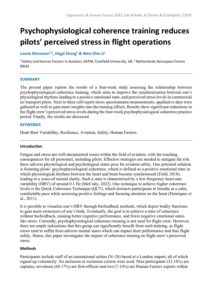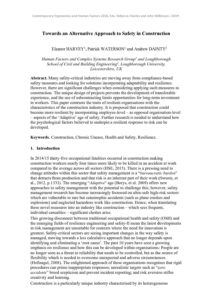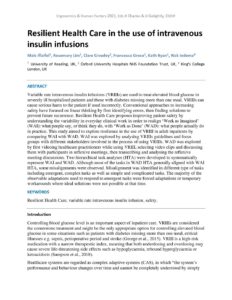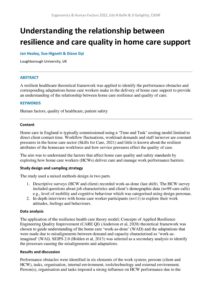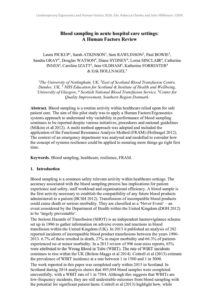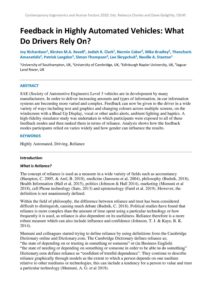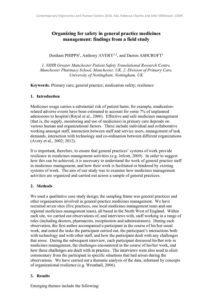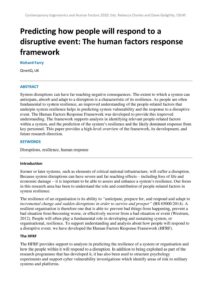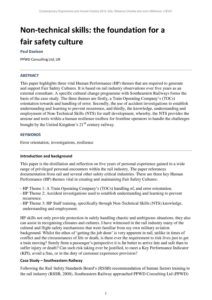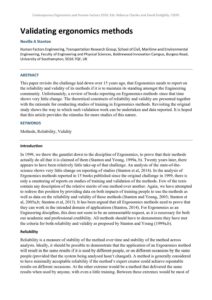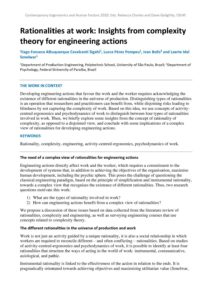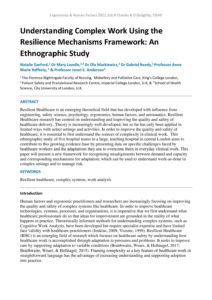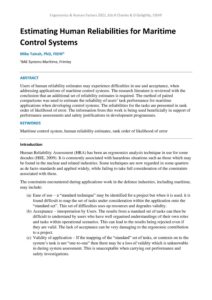Resilience
Psychophysiological coherence training reduces pilots’ perceived stress in flight operations
| Document | Author Laurie Marsman, Jingyi Zhang & Wen-Chin Li |
| Abstract The present paper reports the results of a four-week study assessing the relationship between psychophysiological coherence training, which aims to improve the synchronisation between one’s physiological rhythms leading to a positive emotional state, and perceived stress levels in commercial air transport pilots. Next to three self-report stress questionnaire measurements, qualitative data were gathered as well to gain more insights into the training effects. Results show significant reductions in the flight crew’s perceived stress levels during the four-week psychophysiological coherence practice period. Finally, the results are discussed. |
Towards an Alternative Approach to Safety in Construction
| Document | Author Eleanor HARVEY, Patrick WATERSON and Andrew DAINTY |
| Abstract Many safety-critical industries are moving away from compliance-based safety measures and looking for solutions incorporating adaptability and resilience. However, there are significant challenges when considering applying such measures to construction. The unique design of projects prevents the development of transferable experience, and the use of subcontracting limits opportunities for long-term investment in workers. This paper contrasts the traits of resilient organisations with the characteristics of the construction industry. It is proposed that construction could become more resilient by incorporating employee-level – as opposed organisation-level – aspects of the ‘Adaptive’ age of safety. Further research is needed to understand how the psychological factors believed to underpin a resilient response to risk can be developed. |
Resilient Health Care in the use of intravenous insulin infusions
| Document | Author Mais Iflaifel, Rosemary Lim, Clare Crowley, Francesca Greco, Kath Ryan, Rick Iedema |
| Abstract Variable rate intravenous insulin infusions (VRIIIs) are used to treat elevated blood glucose in severely ill hospitalised patients and those with diabetes missing more than one meal. VRIIIs can cause serious harm to the patient if used incorrectly. Conventional approaches to increasing safety have focused on linear thinking by first identifying errors, then finding solutions to prevent future recurrence. Resilient Health Care proposes improving patient safety by understanding the variability in everyday clinical work in order to realign ‘Work as Imagined’ (WAI): what people say, or think they do, with ‘Work as Done’ (WAD): what people actually do in practice. This study aimed to explore resilience in the use of VRIII in adult inpatients by comparing WAI with WAD. WAI was explored by analysing VRIIIs guidelines and focus groups with different stakeholders involved in the process of using VRIIIs. WAD was explored by first videoing healthcare practitioners while using VRIII, selecting video clips and discussing them with participants in reflexive meetings, then transcribing and analysing the reflexive meeting discussions. Two hierarchical task analyses (HTA) were developed to systematically represent WAI and WAD. Although most of the tasks in WAD HTA generally aligned with WAI HTA, some misalignments were observed. Misalignment was identified in different type of tasks including emergent, complex tasks as well as simple and complicated tasks. The majority of the observable adaptations used to respond to emergent tasks were forced adaptations or temporary workarounds where ideal solutions were not possible at that time. |
Understanding the relationship between resilience and care quality in home care support
| Document | Author Jan Healey, Sue Hignett & Diane Gyi |
| Abstract A resilient healthcare theoretical framework was applied to identify the performance obstacles and corresponding adaptations home care workers make in the delivery of home care support to provide an understanding of the relationship between home care resilience and quality of care. |
Blood sampling in acute hospital care settings: A Human Factors Review
| Document | Author Laura PICKUP, Sarah ATKINSON, Sam RAWLINSON, Paul BOWIE, Sandra GRAY, Douglas WATSON, Diane SYDNEY, Lorna SINCLAIR, Catherine INNES, Caroline IZATT, Jane OLDHAM, Katherine FORRESTER & Erik HOLLNAGEL |
| Abstract Blood sampling is a routine activity within healthcare relied upon for safe patient care. The aim of this pilot study was to apply a Human Factors/Ergonomics systems approach to understand why variability in performance of blood sampling continues to be reported despite various initiatives, procedures and national guidelines (Milkins et al 2012). A multi method approach was adopted and included the application of the Functional Resonance Analysis Method (FRAM) (Hollnagel 2012). The context of an emergency department was analysed and modelled to consider how the concept |
Feedback in Highly Automated Vehicles: What Do Drivers Rely On?
| Document | Author Joy Richardson, Kirsten M.A. Revell, Jediah R. Clark, Nermin Caber, Mike Bradley, Theocharis Amanatidis, Patrick Langdon, Simon Thompson, Lee Skrypchuk, Neville A. Stanton |
| Abstract SAE (Society of Automotive Engineers) Level 3 vehicles are in development by many manufacturers. In order to deliver increasing amounts and types of information, in-car information systems are becoming more varied and complex. Feedback can now be given to the driver in a wide variety of ways including text and graphics and changing colours across multiple screens, on the windscreen with a Head Up Display, vocal or other audio alerts, ambient lighting and haptics. A high-fidelity simulator study was undertaken in which participants were exposed to all of these feedback modes and then ranked them in terms of reliance. Analysis shows how the feedback modes participants relied on varies widely and how gender can influence the results. |
Organizing for safety in general practice medicines management: findings from a field study
| Document | Author Denham PHIPPS, Anthony AVERY, and Darren ASHCROFT |
| Abstract |
Predicting how people will respond to a disruptive event: The human factors response framework
| Document | Author Richard Farry |
| Abstract System disruptions can have far reaching negative consequences. The extent to which a system can anticipate, absorb and adapt to a disruption is a characteristic of its resilience. As people are often fundamental to system resilience, an improved understanding of the people-related factors that underpin system resilience helps in predicting system vulnerability and the response to a disruptive event. The Human Factors Response Framework was developed to provide this improved understanding. The framework supports analysts in identifying relevant people-related factors within a system, and the prediction of the system’s resilience and the likely dominant response from key personnel. This paper provides a high-level overview of the framework, its development, and future research direction. |
Non-technical skills: the foundation for a fair safety culture
| Document | Author Paul Davison |
| Abstract This paper highlights three vital Human Performance (HP) themes that are required to generate and support Fair Safety Cultures. It is based on rail industry observations over five years as an external consultant. A specific cultural change programme with Southeastern Railways forms the basis of the case study. The three themes are firstly, a Train Operating Company’s (TOCs) orientation towards and handling of error. Secondly, the use of accident investigations to establish understanding and learning to prevent recurrence, and thirdly, the knowledge, understanding and employment of Non-Technical Skills (NTS) for staff development, whereby, the NTS provides the armour and tools within a human resilience toolbox for frontline operators to handle the challenges brought by the United Kingdom’s 21st century railway. |
Validating ergonomics methods
| Document | Author Neville A Stanton |
| Abstract This paper revisits the challenge laid down over 15 years ago, that Ergonomics needs to report on the reliability and validity of its methods if it is to maintain its standing amongst the Engineering community. Unfortunately, a review of books reporting on Ergonomics methods since that time shows very little change. The theoretical constructs of reliability and validity are presented together with the rationale for conducting studies of training in Ergonomics methods. Revisiting the original study shows the way in which such validation work can be undertaken and data reported. It is hoped that this article provides the stimulus for more studies of this nature. |
Rationalities at work: Insights from complexity theory for engineering actions
| Document | Author Tiago Fonseca Albuquerque Cavalcanti Sigahi, Lucca Pérez Pompeu, Ivan Bolis and Laerte Idal Sznelwar |
| Abstract Developing engineering actions that favour the work and the worker requires acknowledging the existence of different rationalities in the universe of production. Distinguishing types of rationalities is an operation that researchers and practitioners can benefit from, while disjoining risks leading to blindness by not capturing the complexity of work. Based on this idea, we use concepts of activity-centred ergonomics and psychodynamics of work to distinguish between four types of rationalities involved in work. Then, we briefly explore some insights from the concept of rationality of complexity, as opposed to a disjointed view, and conclude with some implications of a complex view of rationalities for developing engineering actions. |
Understanding Complex Work Using the Resilience Mechanisms Framework: An Ethnographic Study
| Document | Author Natalie Sanford, Dr Mary Lavelle, Dr Ola Markiewicz, Dr Gabriel Reedy, Professor Anne Marie Rafferty, & Professor Janet E. Anderson |
| Abstract Resilient Healthcare is an emerging theoretical field that has developed with influence from engineering, safety science, psychology, ergonomics, human factors, and aeronautics. Resilient Healthcare research has centred on understanding and improving the quality and safety of healthcare delivery. Theory is increasingly well-developed, but so far has only been applied in limited ways with select settings and activities. In order to improve the quality and safety of healthcare, it is essential to first understand the sources of complexity in clinical work. This ethnographic study of five hospital teams in a large, teaching hospital in central London aims to contribute to this growing evidence base by presenting data on specific challenges faced by healthcare workers and the adaptations they use to overcome them in everyday clinical work. This paper will present a new framework for recognising misalignments between demand and capacity and corresponding mechanisms for adaptation, which can be used to understand work-as-done in complex settings and to manage risk. |
Estimating Human Reliabilities for Maritime Control Systems
| Document | Author Mike Tainsh |
| Abstract Users of human reliability estimates may experience difficulties in use and acceptance, when addressing applications of maritime control systems. The research literature is reviewed with the conclusion that an additional set of reliability estimates is required. The method of paired comparisons was used to estimate the reliability of users’ task performance for maritime applications when developing control systems. The reliabilities for the tasks are presented in rank order of likelihood of error. The information from this work is being used beneficially in support of performance assessments and safety justifications in development programmes. |

